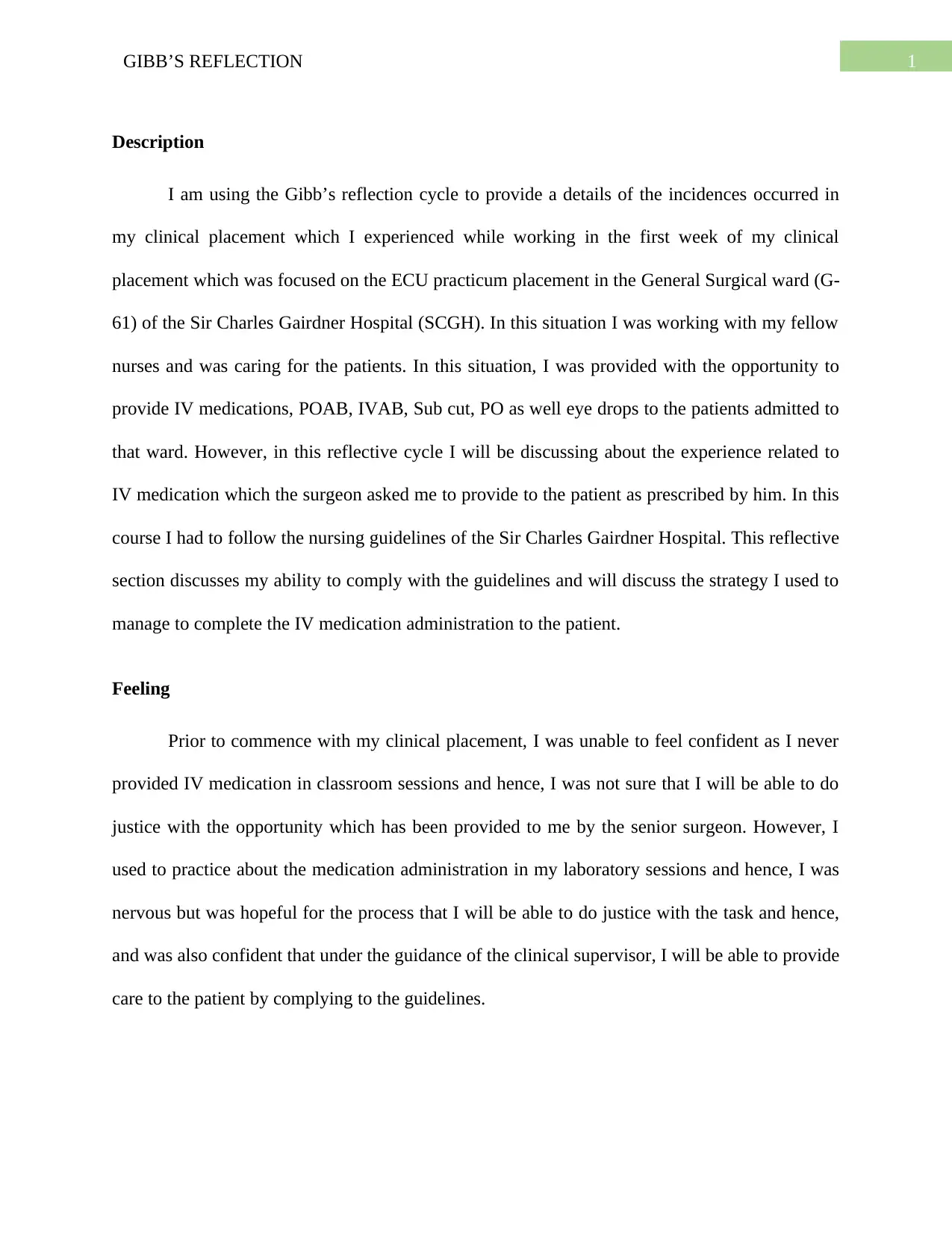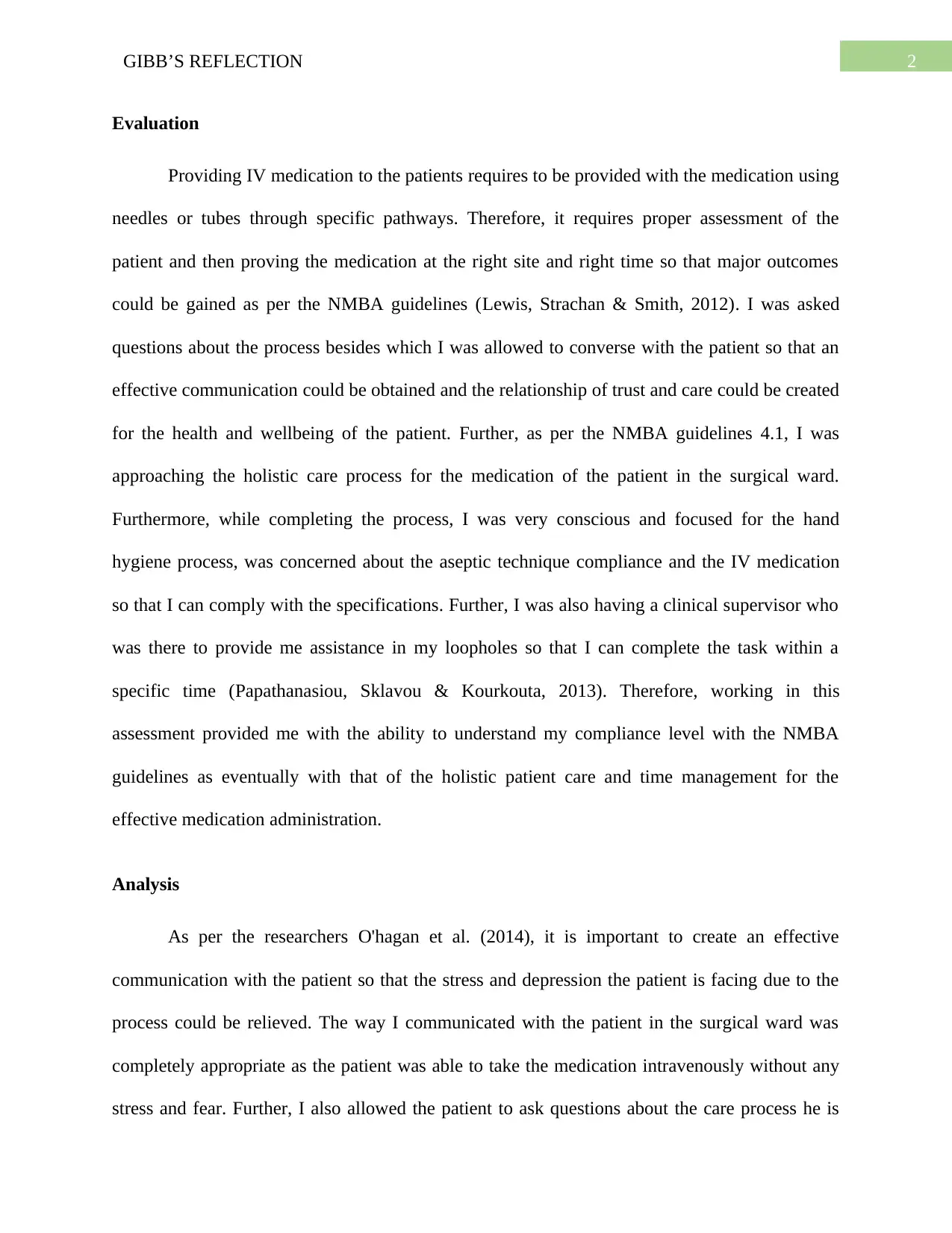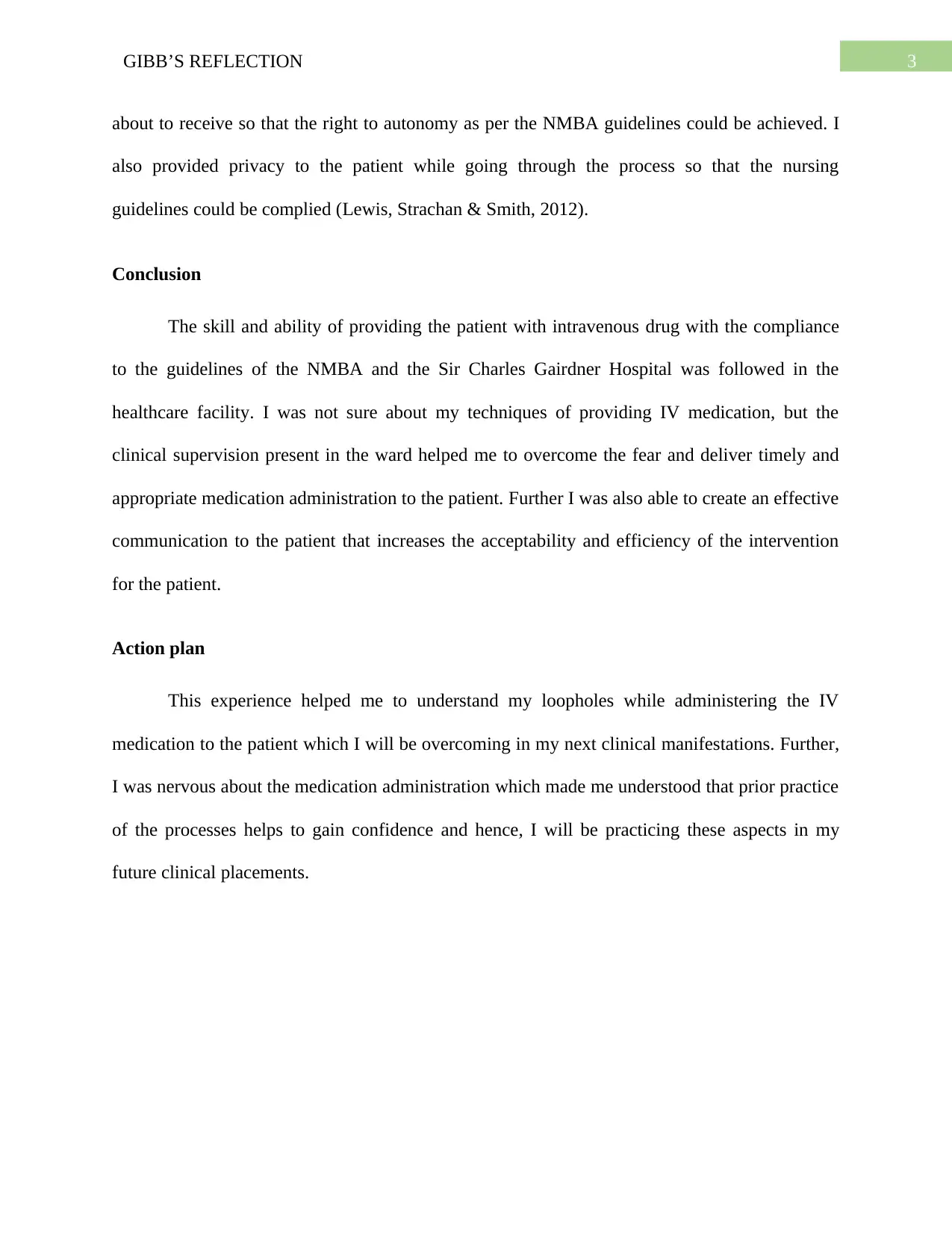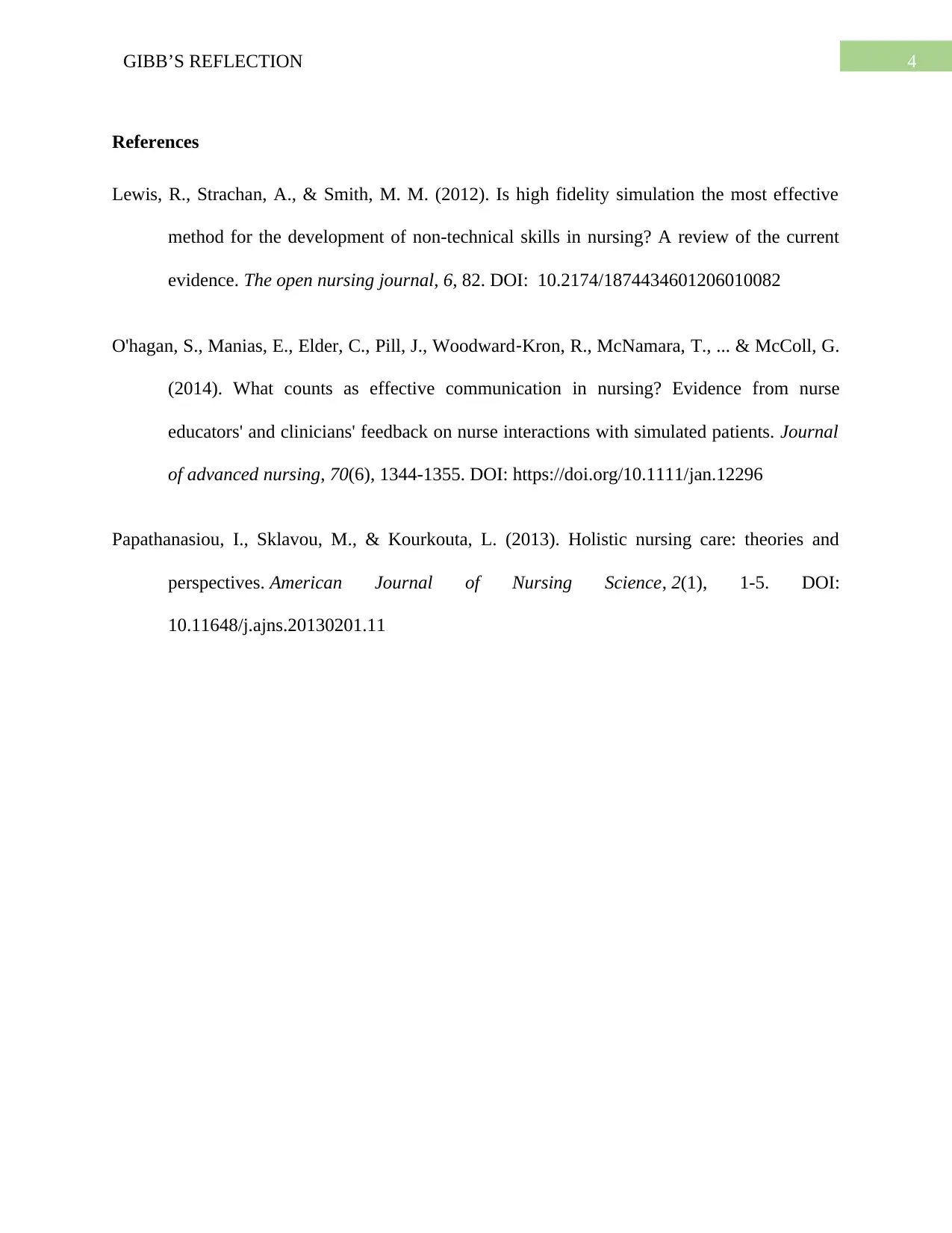ECU Nursing: Gibb's Reflective Cycle on Clinical Experience at SCGH
VerifiedAdded on 2023/06/03
|5
|1074
|479
Essay
AI Summary
This essay presents a nursing student's reflection on their clinical placement experience at Sir Charles Gairdner Hospital (SCGH), specifically in the General Surgical ward (G61). Using Gibb's Reflective Cycle, the student analyzes their initial feelings of nervousness regarding IV medication administration, their actions in providing the medication under supervision, and their communication with the patient. The reflection evaluates the student's compliance with NMBA guidelines and hospital protocols, concluding with an action plan for future clinical practice to address identified weaknesses and build confidence through further practice and learning. The student highlights the importance of effective communication, aseptic techniques, and time management in ensuring positive patient outcomes. This assignment is available on Desklib, where students can access a wide range of study tools and resources.

Running head: GIBB’S REFLECTION
NURSING ASSIGNMENT
Name of the Student
Name of the University
Author note
NURSING ASSIGNMENT
Name of the Student
Name of the University
Author note
Paraphrase This Document
Need a fresh take? Get an instant paraphrase of this document with our AI Paraphraser

1GIBB’S REFLECTION
Description
I am using the Gibb’s reflection cycle to provide a details of the incidences occurred in
my clinical placement which I experienced while working in the first week of my clinical
placement which was focused on the ECU practicum placement in the General Surgical ward (G-
61) of the Sir Charles Gairdner Hospital (SCGH). In this situation I was working with my fellow
nurses and was caring for the patients. In this situation, I was provided with the opportunity to
provide IV medications, POAB, IVAB, Sub cut, PO as well eye drops to the patients admitted to
that ward. However, in this reflective cycle I will be discussing about the experience related to
IV medication which the surgeon asked me to provide to the patient as prescribed by him. In this
course I had to follow the nursing guidelines of the Sir Charles Gairdner Hospital. This reflective
section discusses my ability to comply with the guidelines and will discuss the strategy I used to
manage to complete the IV medication administration to the patient.
Feeling
Prior to commence with my clinical placement, I was unable to feel confident as I never
provided IV medication in classroom sessions and hence, I was not sure that I will be able to do
justice with the opportunity which has been provided to me by the senior surgeon. However, I
used to practice about the medication administration in my laboratory sessions and hence, I was
nervous but was hopeful for the process that I will be able to do justice with the task and hence,
and was also confident that under the guidance of the clinical supervisor, I will be able to provide
care to the patient by complying to the guidelines.
Description
I am using the Gibb’s reflection cycle to provide a details of the incidences occurred in
my clinical placement which I experienced while working in the first week of my clinical
placement which was focused on the ECU practicum placement in the General Surgical ward (G-
61) of the Sir Charles Gairdner Hospital (SCGH). In this situation I was working with my fellow
nurses and was caring for the patients. In this situation, I was provided with the opportunity to
provide IV medications, POAB, IVAB, Sub cut, PO as well eye drops to the patients admitted to
that ward. However, in this reflective cycle I will be discussing about the experience related to
IV medication which the surgeon asked me to provide to the patient as prescribed by him. In this
course I had to follow the nursing guidelines of the Sir Charles Gairdner Hospital. This reflective
section discusses my ability to comply with the guidelines and will discuss the strategy I used to
manage to complete the IV medication administration to the patient.
Feeling
Prior to commence with my clinical placement, I was unable to feel confident as I never
provided IV medication in classroom sessions and hence, I was not sure that I will be able to do
justice with the opportunity which has been provided to me by the senior surgeon. However, I
used to practice about the medication administration in my laboratory sessions and hence, I was
nervous but was hopeful for the process that I will be able to do justice with the task and hence,
and was also confident that under the guidance of the clinical supervisor, I will be able to provide
care to the patient by complying to the guidelines.

2GIBB’S REFLECTION
Evaluation
Providing IV medication to the patients requires to be provided with the medication using
needles or tubes through specific pathways. Therefore, it requires proper assessment of the
patient and then proving the medication at the right site and right time so that major outcomes
could be gained as per the NMBA guidelines (Lewis, Strachan & Smith, 2012). I was asked
questions about the process besides which I was allowed to converse with the patient so that an
effective communication could be obtained and the relationship of trust and care could be created
for the health and wellbeing of the patient. Further, as per the NMBA guidelines 4.1, I was
approaching the holistic care process for the medication of the patient in the surgical ward.
Furthermore, while completing the process, I was very conscious and focused for the hand
hygiene process, was concerned about the aseptic technique compliance and the IV medication
so that I can comply with the specifications. Further, I was also having a clinical supervisor who
was there to provide me assistance in my loopholes so that I can complete the task within a
specific time (Papathanasiou, Sklavou & Kourkouta, 2013). Therefore, working in this
assessment provided me with the ability to understand my compliance level with the NMBA
guidelines as eventually with that of the holistic patient care and time management for the
effective medication administration.
Analysis
As per the researchers O'hagan et al. (2014), it is important to create an effective
communication with the patient so that the stress and depression the patient is facing due to the
process could be relieved. The way I communicated with the patient in the surgical ward was
completely appropriate as the patient was able to take the medication intravenously without any
stress and fear. Further, I also allowed the patient to ask questions about the care process he is
Evaluation
Providing IV medication to the patients requires to be provided with the medication using
needles or tubes through specific pathways. Therefore, it requires proper assessment of the
patient and then proving the medication at the right site and right time so that major outcomes
could be gained as per the NMBA guidelines (Lewis, Strachan & Smith, 2012). I was asked
questions about the process besides which I was allowed to converse with the patient so that an
effective communication could be obtained and the relationship of trust and care could be created
for the health and wellbeing of the patient. Further, as per the NMBA guidelines 4.1, I was
approaching the holistic care process for the medication of the patient in the surgical ward.
Furthermore, while completing the process, I was very conscious and focused for the hand
hygiene process, was concerned about the aseptic technique compliance and the IV medication
so that I can comply with the specifications. Further, I was also having a clinical supervisor who
was there to provide me assistance in my loopholes so that I can complete the task within a
specific time (Papathanasiou, Sklavou & Kourkouta, 2013). Therefore, working in this
assessment provided me with the ability to understand my compliance level with the NMBA
guidelines as eventually with that of the holistic patient care and time management for the
effective medication administration.
Analysis
As per the researchers O'hagan et al. (2014), it is important to create an effective
communication with the patient so that the stress and depression the patient is facing due to the
process could be relieved. The way I communicated with the patient in the surgical ward was
completely appropriate as the patient was able to take the medication intravenously without any
stress and fear. Further, I also allowed the patient to ask questions about the care process he is
⊘ This is a preview!⊘
Do you want full access?
Subscribe today to unlock all pages.

Trusted by 1+ million students worldwide

3GIBB’S REFLECTION
about to receive so that the right to autonomy as per the NMBA guidelines could be achieved. I
also provided privacy to the patient while going through the process so that the nursing
guidelines could be complied (Lewis, Strachan & Smith, 2012).
Conclusion
The skill and ability of providing the patient with intravenous drug with the compliance
to the guidelines of the NMBA and the Sir Charles Gairdner Hospital was followed in the
healthcare facility. I was not sure about my techniques of providing IV medication, but the
clinical supervision present in the ward helped me to overcome the fear and deliver timely and
appropriate medication administration to the patient. Further I was also able to create an effective
communication to the patient that increases the acceptability and efficiency of the intervention
for the patient.
Action plan
This experience helped me to understand my loopholes while administering the IV
medication to the patient which I will be overcoming in my next clinical manifestations. Further,
I was nervous about the medication administration which made me understood that prior practice
of the processes helps to gain confidence and hence, I will be practicing these aspects in my
future clinical placements.
about to receive so that the right to autonomy as per the NMBA guidelines could be achieved. I
also provided privacy to the patient while going through the process so that the nursing
guidelines could be complied (Lewis, Strachan & Smith, 2012).
Conclusion
The skill and ability of providing the patient with intravenous drug with the compliance
to the guidelines of the NMBA and the Sir Charles Gairdner Hospital was followed in the
healthcare facility. I was not sure about my techniques of providing IV medication, but the
clinical supervision present in the ward helped me to overcome the fear and deliver timely and
appropriate medication administration to the patient. Further I was also able to create an effective
communication to the patient that increases the acceptability and efficiency of the intervention
for the patient.
Action plan
This experience helped me to understand my loopholes while administering the IV
medication to the patient which I will be overcoming in my next clinical manifestations. Further,
I was nervous about the medication administration which made me understood that prior practice
of the processes helps to gain confidence and hence, I will be practicing these aspects in my
future clinical placements.
Paraphrase This Document
Need a fresh take? Get an instant paraphrase of this document with our AI Paraphraser

4GIBB’S REFLECTION
References
Lewis, R., Strachan, A., & Smith, M. M. (2012). Is high fidelity simulation the most effective
method for the development of non-technical skills in nursing? A review of the current
evidence. The open nursing journal, 6, 82. DOI: 10.2174/1874434601206010082
O'hagan, S., Manias, E., Elder, C., Pill, J., Woodward‐Kron, R., McNamara, T., ... & McColl, G.
(2014). What counts as effective communication in nursing? Evidence from nurse
educators' and clinicians' feedback on nurse interactions with simulated patients. Journal
of advanced nursing, 70(6), 1344-1355. DOI: https://doi.org/10.1111/jan.12296
Papathanasiou, I., Sklavou, M., & Kourkouta, L. (2013). Holistic nursing care: theories and
perspectives. American Journal of Nursing Science, 2(1), 1-5. DOI:
10.11648/j.ajns.20130201.11
References
Lewis, R., Strachan, A., & Smith, M. M. (2012). Is high fidelity simulation the most effective
method for the development of non-technical skills in nursing? A review of the current
evidence. The open nursing journal, 6, 82. DOI: 10.2174/1874434601206010082
O'hagan, S., Manias, E., Elder, C., Pill, J., Woodward‐Kron, R., McNamara, T., ... & McColl, G.
(2014). What counts as effective communication in nursing? Evidence from nurse
educators' and clinicians' feedback on nurse interactions with simulated patients. Journal
of advanced nursing, 70(6), 1344-1355. DOI: https://doi.org/10.1111/jan.12296
Papathanasiou, I., Sklavou, M., & Kourkouta, L. (2013). Holistic nursing care: theories and
perspectives. American Journal of Nursing Science, 2(1), 1-5. DOI:
10.11648/j.ajns.20130201.11
1 out of 5
Related Documents
Your All-in-One AI-Powered Toolkit for Academic Success.
+13062052269
info@desklib.com
Available 24*7 on WhatsApp / Email
![[object Object]](/_next/static/media/star-bottom.7253800d.svg)
Unlock your academic potential
Copyright © 2020–2025 A2Z Services. All Rights Reserved. Developed and managed by ZUCOL.





